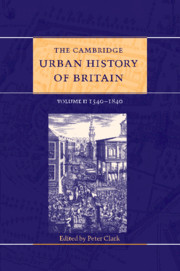Book contents
- Frontmatter
- 1 Introduction
- Part I Area surveys 1540–1840
- Introduction
- 2(a) England: East Anglia
- 2(b) England: South-East
- 2(c) England: South-West
- 2(d) England: Midlands
- 2(e) England: North
- 3 Wales
- 4 Scotland
- Part II Urban themes and types 1540–1700
- Part III Urban themes and types 1700–1840
- Select Bibliography
- Index
- References
2(e) - England: North
from Part I - Area surveys 1540–1840
Published online by Cambridge University Press: 28 March 2008
- Frontmatter
- 1 Introduction
- Part I Area surveys 1540–1840
- Introduction
- 2(a) England: East Anglia
- 2(b) England: South-East
- 2(c) England: South-West
- 2(d) England: Midlands
- 2(e) England: North
- 3 Wales
- 4 Scotland
- Part II Urban themes and types 1540–1700
- Part III Urban themes and types 1700–1840
- Select Bibliography
- Index
- References
Summary
THE NATURE OF THE REGION
urban growth in parts of northern England during the three centuries under review was spectacular even by the standards of the first industrial nation. It was spectacular in the literal sense that by the early decades of the nineteenth century not only business travellers but also tourists and social commentators were coming to marvel at the novel concentration of factories using fossil fuels in an urban setting in and around Manchester, and at the sheer scale of urban maritime and manufacturing activity in the other towns which were cohering and coalescing. The great industrial and commercial centres gathered up systems of satellite towns in their surrounding districts, conjuring up in one visiting mind the telling image of Manchester as a ‘diligent spider’ at the heart of its web of communications. These were accelerating developments, and they reached their most dramatic, interesting and historically important phase between the late eighteenth century and the mid-nineteenth, when these new towns were at their most raw, untrammelled, dramatic, exciting and threatening: ‘great human exploits’ which produced and distributed a cornucopia of goods under a shroud of infernal smoke and under conditions which visibly threatened life, health and social and political stability. Provincial urban developments within the North had turned it into a symbol of the future, which might or might not work in the longer term, and by the 1840s the urban concentrations of the region had become the cynosure of the informed contemporary gaze. It therefore makes sense to begin this survey with an analysis of the scale and scope of urbanization within the region in 1840, and then to examine the roots of these unprecedented phenomena and attempt to describe and explain their development.
- Type
- Chapter
- Information
- The Cambridge Urban History of Britain , pp. 111 - 132Publisher: Cambridge University PressPrint publication year: 2000
References
- 1
- Cited by



